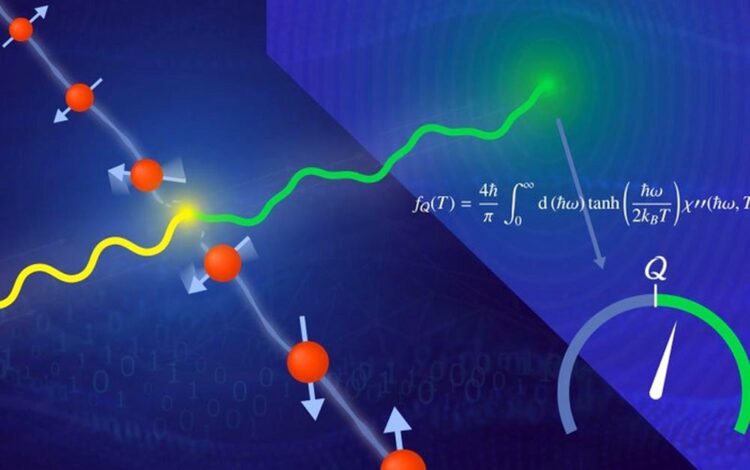Spilling the secrets of quantum entanglement

A material’s spins, depicted as red spheres, are probed by scattered neutrons. Applying an entanglement witness causes the neutrons to form a kind of quantum gauge capable of distinguishing between classical and quantum spin fluctuations.
Image courtesy of Nathan Armistead, Oak Ridge National Laboratory
Quantum technique accelerates identification of entangled materials.
The Science
Quantum materials behave in surprising ways because of quantum physics. For example, they can be superconductors, which can allow electricity to flow with no resistance. These materials could lead to completely new technologies. In an advance for quantum materials, scientists tested the ability of techniques called entanglement witnesses to accurately identify pairs of entangled magnetic particles. Entanglement is when one of these particles, or “spins,” mirrors another’s properties and behavior regardless of the distance between them. This research evaluated three entanglement witnesses. Of the three, quantum Fisher information (QFI) performed the best, routinely locating entanglement in complex materials. QFI also differentiated between true quantum activity and non-quantum activity that can appear quantum due to random thermal motion. In addition, the experiments confirmed that entanglement increases as temperature decreases.
The Impact
This work is the most thorough examination of QFI’s capabilities to date. It is also the first to apply the technique to massive solid materials by examining many pairs of entangled spins simultaneously. With QFI, scientists can more quickly identify entangled quantum materials such as quantum spin liquids, quantum magnets, and superconductors. These materials are ideal for applications such as data storage and computing. Incorporating QFI calculations into future neutron scattering experiments could help research teams characterize even more complex quantum materials.
Summary
Proving the presence of entanglement in one-dimensional spin chains—linear lines of connected spins within quantum materials—has historically been a major challenge in quantum information science. The team observed QFI tackling this challenge by applying the witness to neutron scattering experiments at the Spallation Neutron Source, a Department of Energy user facility. Because of their neutral charge and nondestructive nature, the neutrons provided valuable insights into the properties of two different spin chains. To validate their results, the researchers also ran computational simulations and analyzed data from older experiments conducted at the ISIS Neutron Source and the Institut Laue-Langevin.
Funding
This work was funded by the Department of Energy Office of Science, DOE’s Scientific Discovery through Advanced Computing program, Oak Ridge National Laboratory’s Laboratory Directed Research and Development program, the Quantum Science Center, the Center for Nanophase Materials Sciences, and the European Research Council under the European Union Horizon 2020 Research and Innovation Programme.
Media Contact
Michael Church
DOE/US Department of Energy
michael.church@science.doe.gov
Office: 2028416299
Original Source
https://www.energy.gov/science/ascr/articles/spilling-secrets-quantum-entanglement
All latest news from the category: Materials Sciences
Materials management deals with the research, development, manufacturing and processing of raw and industrial materials. Key aspects here are biological and medical issues, which play an increasingly important role in this field.
innovations-report offers in-depth articles related to the development and application of materials and the structure and properties of new materials.
Newest articles

Innovative 3D printed scaffolds offer new hope for bone healing
Researchers at the Institute for Bioengineering of Catalonia have developed novel 3D printed PLA-CaP scaffolds that promote blood vessel formation, ensuring better healing and regeneration of bone tissue. Bone is…

The surprising role of gut infection in Alzheimer’s disease
ASU- and Banner Alzheimer’s Institute-led study implicates link between a common virus and the disease, which travels from the gut to the brain and may be a target for antiviral…

Molecular gardening: New enzymes discovered for protein modification pruning
How deubiquitinases USP53 and USP54 cleave long polyubiquitin chains and how the former is linked to liver disease in children. Deubiquitinases (DUBs) are enzymes used by cells to trim protein…



